The AMD A8-7650K APU Review, Also New Testing Methodology
by Ian Cutress on May 12, 2015 10:00 AM ESTGaming Benchmarks: Mid-Range
Alien: Isolation
If first person survival mixed with horror is your sort of thing, then Alien: Isolation, based off of the Alien franchise, should be an interesting title. Developed by The Creative Assembly and released in October 2014, Alien: Isolation has won numerous awards from Game Of The Year to several top 10s/25s and Best Horror titles, ratcheting up over a million sales by February 2015. Alien: Isolation uses a custom built engine which includes dynamic sound effects and should be fully multi-core enabled.
For low end graphics, we test at 720p with Ultra settings, whereas for mid and high range graphics we bump this up to 1080p, taking the average frame rate as our marker with a scripted version of the built-in benchmark.
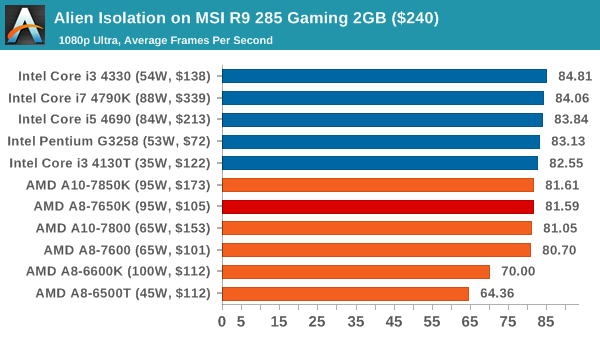
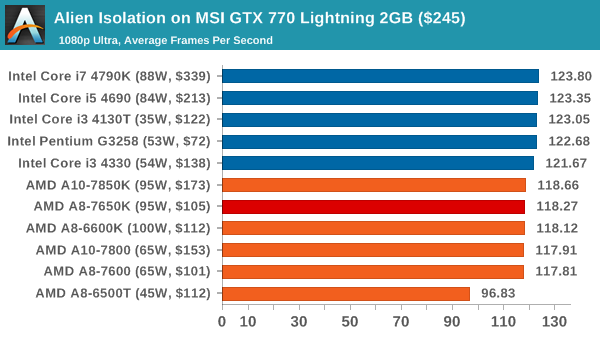
For mid range cards, Alien Isolation has a direct split for Intel and AMD, but the difference is a few FPS at best. It would seem that cores matter not here.
Total War: Attila
The Total War franchise moves on to Attila, another The Creative Assembly development, and is a stand-alone strategy title set in 395AD where the main story line lets the gamer take control of the leader of the Huns in order to conquer parts of the world. Graphically the game can render hundreds/thousands of units on screen at once, all with their individual actions and can put some of the big cards to task.
For low end graphics, we test at 720p with performance settings, recording the average frame rate. With mid and high range graphics, we test at 1080p with the quality setting. In both circumstances, unlimited video memory is enabled and the in-game scripted benchmark is used.
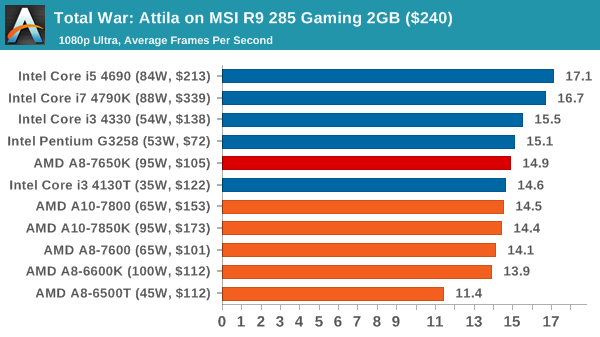
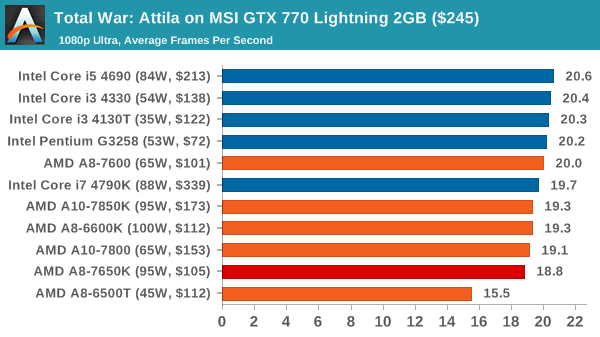
Neither combination here pulls Attila into a reasonable gaming rate, although there are bigger differences using the R9 285 GPU.
Grand Theft Auto V
The highly anticipated iteration of the Grand Theft Auto franchise finally hit the shelves on April 14th 2015, with both AMD and NVIDIA in tow to help optimize the title. GTA doesn’t provide graphical presets, but opens up the options to users and extends the boundaries by pushing even the hardest systems to the limit using Rockstar’s Advanced Game Engine. Whether the user is flying high in the mountains with long draw distances or dealing with assorted trash in the city, when cranked up to maximum it creates stunning visuals but hard work for both the CPU and the GPU.
For our test we have scripted a version of the in-game benchmark, relying only on the final part which combines a flight scene along with an in-city drive-by followed by a tanker explosion. For low end systems we test at 720p on the lowest settings, whereas mid and high end graphics play at 1080p with very high settings across the board. We record both the average frame rate and the percentage of frames under 60 FPS (16.6ms).
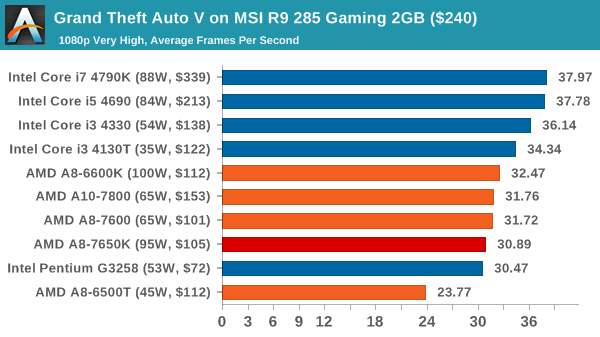
![Grand Theft Auto V on MSI R9 285 Gaming 2GB ($240) [Under 60 FPS]](https://images.anandtech.com/graphs/graph9217/74236.png)

![Grand Theft Auto V on MSI GTX 770 Lightning 2GB ($245) [Under 60 FPS]](https://images.anandtech.com/graphs/graph9217/74246.png)
On GTA, the G3258, the i3-4130T and the A8-7650K perform similarly, within a few frames of each other. Though in both circumstances the $200+ CPUs give the peak performance, up to 20% more than the $100 set.
GRID: Autosport
No graphics tests are complete without some input from Codemasters and the EGO engine, which means for this round of testing we point towards GRID: Autosport, the next iteration in the GRID and racing genre. As with our previous racing testing, each update to the engine aims to add in effects, reflections, detail and realism, with Codemasters making ‘authenticity’ a main focal point for this version.
GRID’s benchmark mode is very flexible, and as a result we created a test race using a shortened version of the Red Bull Ring with twelve cars doing two laps. The car is focus starts last and is quite fast, but usually finishes second or third. For low end graphics we test at 1080p medium settings, whereas mid and high end graphics get the full 1080p maximum. Both the average and minimum frame rates are recorded.
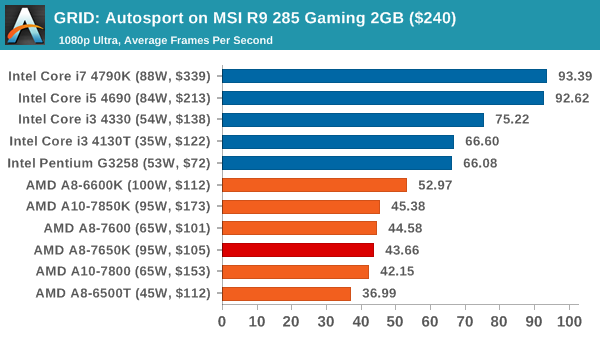
![GRID: Autosport on MSI R9 285 Gaming 2GB ($240) [Minimum FPS]](https://images.anandtech.com/graphs/graph9217/74238.png)

![GRID: Autosport on MSI GTX 770 Lightning 2GB ($245) [Minimum FPS]](https://images.anandtech.com/graphs/graph9217/74248.png)
GRID on an R9 285 seems to love Intel and loves more cores, as shown by the jump from the i3 to the i5. Whereas on a GTX 770, both teams perform similarly, well north of 60 FPS, although the difference lies more in the minimum frame rates.
Middle-Earth: Shadows of Mordor
The final title in our testing is another battle of system performance with the open world action-adventure title, Shadows of Mordor. Produced by Monolith using the LithTech Jupiter EX engine and numerous detail add-ons, SoM goes for detail and complexity to a large extent, despite having to be cut down from the original plans. The main story itself was written by the same writer as Red Dead Redemption, and it received Zero Punctuation’s Game of The Year in 2014.
For testing purposes, SoM gives a dynamic screen resolution setting, allowing us to render at high resolutions that are then scaled down to the monitor. As a result, we get several tests using the in-game benchmark. For low end graphics we examine at 720p with low settings, whereas mid and high end graphics get 1080p Ultra. The top graphics test is also redone at 3840x2160, also with Ultra settings, and we also test two cards at 4K where possible.
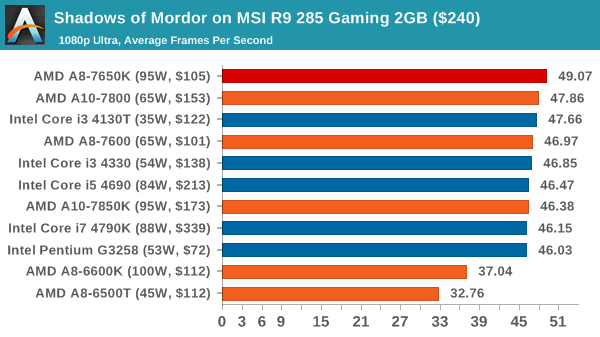
![Shadows of Mordor on MSI R9 285 Gaming 2GB ($240) [Minimum FPS]](https://images.anandtech.com/graphs/graph9217/74240.png)
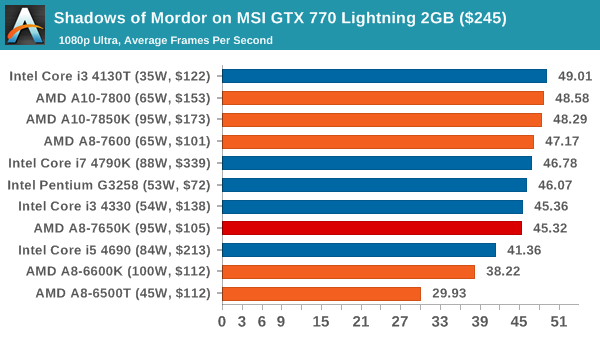
![Shadows of Mordor on MSI GTX 770 Lightning 2GB ($245) [Minimum FPS]](https://images.anandtech.com/graphs/graph9217/74250.png)
Interestingly the APUs so well at 1080p SoM, especially in average frame rates. Unfortunately this does not translate well in minimum frame rates.
Middle-Earth: Shadows of Mordor at 4K
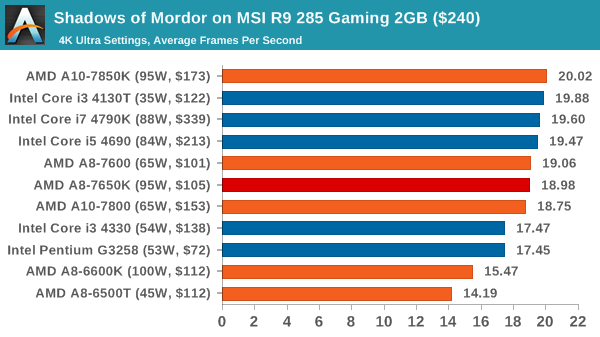
![Shadows of Mordor on MSI R9 285 Gaming 2GB ($240) [Minimum FPS]](https://images.anandtech.com/graphs/graph9217/74240.png)
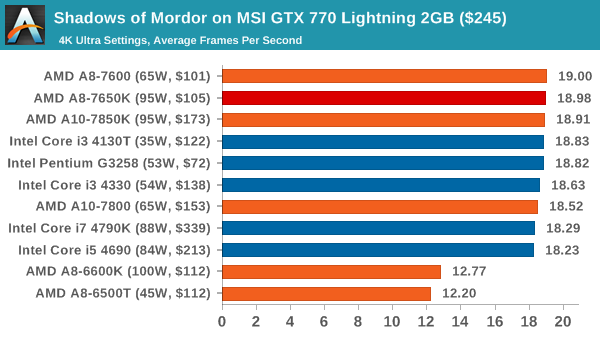
![Shadows of Mordor on MSI GTX 770 Lightning 2GB ($245) [Minimum FPS]](https://images.anandtech.com/graphs/graph9217/74252.png)
At 4K, the older 6000 series APUs seem to be a little behind. With the R9 285 there is also a staggered affect in average FPS performance, although a clear definition in minimum frame rates.















177 Comments
View All Comments
TheJian - Friday, May 15, 2015 - link
I don't think it's sheer luck when you're doing one of two things: 1. you write the compiler they're using. 2. you're the chip/platform etc they are DOING the coding on and thus optimizing for best perf on the platform they're using. Granted, these two things might not help in ALL cases, but it's a pretty sure bet if EVERYONE decided to code their app/game ON Intel/Nvidia, if you're AMD you're not likely to win many things. You may code how you know how to code, but you OPTIMIZE for whatever is in your hands, and get to others if financing allows (or someone pays you, like Dice/B4F netting 8mil for frostbite running on mantle).If you don't have access for platform X, and it runs well on it vs. platform Y that you program on, THEN that was luck. But when it runs well on what you're programming/compiling on, that probably has much less to do with luck. It's just common sense to get that. I'm not saying that's the case here, but you're making a general statement that would seem to go against simple logic in what I'd guess was MOST cases. IE, how many ports of console games do you see that are BETTER on a PC. In most cases we get "another crappy port" comments all over the place. Consoles are admittedly (generally) a worst case scenario, but you get the point. Usually the 2nd platform etc is an afterthought to milk the original cow, not coded with the care of the main platform. Large firms with bigger teams (EA, Blizzard etc) may depend on the skill of the teams doing said work (but even then it's quite rare), but for smaller firms where financing is a big issue, other platform optimization may never happen at all.
Why do you think Nvidia bought a company like PGI? To make sure they were on even footing with Intel compilers for HPC. Being the vid card that ~75% of workstations and 76% of gamers (according to peddie) use doesn't hurt either, but compilers/tools are a big help too.
shadowjk - Friday, May 15, 2015 - link
Linux has adapted to some AMD specialities rather quickly, like the module/core division, and further back in time, discovered you could have iommu on amd cpus before they even were released.Unfortunately, I don't think AMD participates as actively in compiler development..
LarsBars - Tuesday, May 12, 2015 - link
Glad to see the IGP benchmarks updated, they are so much more relevant now! No more 1280x1024 ;) Great work!BrokenCrayons - Wednesday, May 13, 2015 - link
I agree, the new IGP benchmarks are a much-needed realignment to make them more current.darkfalz - Tuesday, May 12, 2015 - link
I love AMD's naming scheme, mimicking Intel's but using higher numbers. I wonder how many would fall for that? Surely a 7850K is much faster than a 4560K? And an A8 or A10 clearly a better CPU than an i5 or i7? Awesome chutzpah.akamateau - Tuesday, May 12, 2015 - link
Another piece of JUNK SCIENCE and yellow journalism from the journalistically bankrupt Anand Tech.What happened to the API Overhead Tests?
What HAPPENED to the DX12 benchmarks?
I am not INTERESTED in OBSOLETE GARBAGE.
There is nothing that you use for benchmarking that is relevant.
ALL gaming is now written to DX11 MAXSPEC. DX12 MINSPEC is 12x broader and allows for far more performance.
When you FAIL to use relevant benchmarks the you are LYING to the consumer.
ANAND TECH is nothing more than a garbage website.
extide - Tuesday, May 12, 2015 - link
This isnt a GPU benchmark article, it is a CPU benchmark articleCrunchy005 - Tuesday, May 12, 2015 - link
Why are you even here reading the articles or commenting on them if you think they are garbage?Michael Bay - Tuesday, May 12, 2015 - link
Your post lacks capitalization.NeatOman - Wednesday, May 13, 2015 - link
this is the only time I've liked what Michael Bay has said or done lol